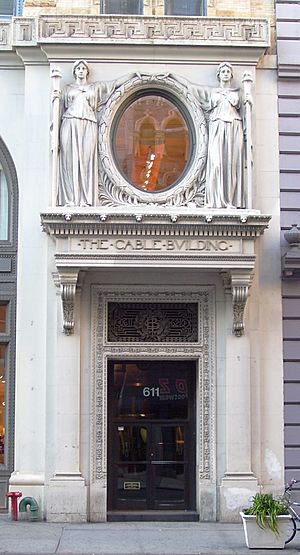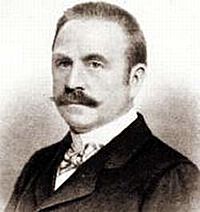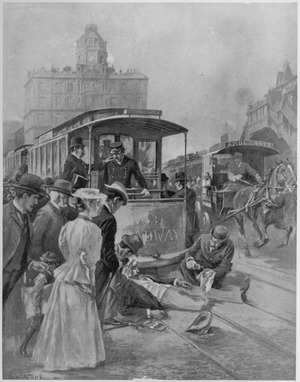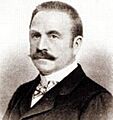Cable Building (New York City) facts for kids
Quick facts for kids Cable Building |
|
|---|---|
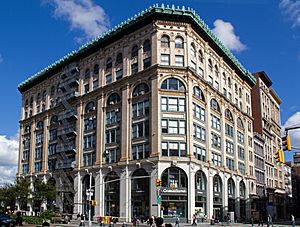
The Cable Building from the south (2011)
|
|
| Location | 611 Broadway, New York, New York |
| Built | 1894 |
| Architect | Stanford White; McKim, Mead & White |
| Architectural style(s) | Beaux-Arts |
| Designated | June 29, 1999 |
| Part of | NoHo Historic District |
| Lua error in Module:Location_map at line 420: attempt to index field 'wikibase' (a nil value). | |
The Cable Building is a famous building located at 611 Broadway in New York City. It stands at the corner of Broadway and Houston Street in the NoHo and Greenwich Village areas of Manhattan. Because it covers a whole block, the building also has entrances on West Houston Street and Mercer Street.
Contents
Building the Cable Building
The Cable Building was constructed between 1892 and 1894. It has a strong frame made of steel and iron. The outside is covered with brick, stone, and terra-cotta. The bottom part is made of light-colored limestone. It features large display windows with fancy iron designs.
The building also has a big copper decoration at the top. This decoration includes lion faces and other detailed patterns. Experts believe this was the first time the famous architecture firm McKim, Mead & White used a full steel frame for a business building.
In 1892, a newspaper called the Real Estate Record and Builders Guide wrote about the building. They said it was the start of a "transformation of Broadway." They mentioned that the Broadway Cable Railroad Company was building its large power station and office building there.
When the building was finished, the same newspaper was very excited. They called it "magnificent" and said its design showed the "highest achievement of art" in America. They felt it was a great example of American design for business needs. The newspaper also noted that the top two floors were used by the Metropolitan Traction Company. The other six floors were available for rent.
The newspaper especially liked the building's western entrance. Above this entrance, there are two large statues of draped female figures. These statues are 11 feet tall and were made by a famous sculptor named J. Massey Rhind. He was a leader in the "American Renaissance" art movement, just like the architect Stanford White.
Who Designed It?
The Cable Building was designed by Stanford White. He was a partner in the very important American architecture firm McKim, Mead & White. This company was famous around the year 1900. The building is nine stories tall and designed in the Beaux-Arts style. This style shows White's ideas for the "American Renaissance" movement.
The Cable Building is the only building by McKim, Mead & White in the NoHo Historic District. Its design is similar to two other buildings the firm designed earlier. These include a building at 900 Broadway and the old Hotel Imperial. Stanford White was in charge of these projects too.
The Cable Building was special because it had two main uses. It was a large power station and also a modern office building. This was quite unique for McKim, Mead & White. The firm did design other power stations, like one for Niagara Falls and another for the Interborough Rapid Transit Company. However, those were only power stations. Most of McKim, Mead & White's work was for public buildings or grand homes.
Out of 29 American cities that built cable car systems between 1870 and 1900, the Cable Building is special. It is the only power station built by such a famous architect. Most cable car powerhouses were very plain and built only for their purpose. But because the Cable Building was on a main street like Broadway, the owners wanted it to look grand.
Original Purpose
The Cable Building was first the main office and power station for the Metropolitan Traction Company. This company ran the city's cable cars. The company was formed in 1892 by a group of powerful businessmen. They invested $750,000 in the building.
Overall, the company spent $12 million on a cable car system for Broadway. This system moved cars from Bowling Green to 36th Street. It was the most expensive system in the country for its size. When it started in 1893, it had 125 cable cars. It served 100,000 passengers every day. The Cable Building was the main power station for this system.
The basement of the building was dug very deep, about 46 feet under the street. It held four huge wheels, 32 feet wide. These wheels carried the cables that pulled the streetcars. Big steam engines powered these wheels. The top seven floors of the building were offices. They were built around a large open space inside with two light wells.
Less than ten years after it was built, cable car technology became old-fashioned. In 1901, the company switched to electric streetcars. But the building kept its original name. The last Broadway cable car ran on May 21, 1901. This marked the end of cable car transportation in New York City.
What It's Like Today
The New York Railways Company sold the Cable Building in 1925. After that, many small businesses and factories moved in. From the 1940s to the 1970s, it was mostly used by clothing makers.
In 1983, the building was changed back into offices. New shops were added on the ground floor. M. D. Carlisle Real Estate has owned the Cable Building since 1985.
The basement, which used to hold the cable car power station, is now home to the Angelika Film Center. This is a movie theater that shows special art house films. Part of the ground floor and all of the second floor have been used by a large Crate & Barrel store since 2002. The other seven floors are still used as offices.
Protecting History
The Cable Building was made part of the NoHo Historic District in 1999. This was done by the New York City Landmarks Preservation Commission. This district includes about 125 buildings. It shows New York City's business history from the 1850s to the 1910s. During this time, the area was a major center for retail and wholesale goods.
Famous architects designed beautiful store and loft buildings in popular styles. This created a rich look for the streets. Shoppers would walk around, look at windows, and buy things. The district also has older houses and other buildings. All of these show the different stages of the area's development. Today, the streets look powerful and unified with buildings made of marble, cast-iron, limestone, brick, and terracotta.
The Cable Building is not currently listed on the National Register of Historic Places on its own.
Images for kids
See also
 In Spanish: Cable Building (Nueva York) para niños
In Spanish: Cable Building (Nueva York) para niños


